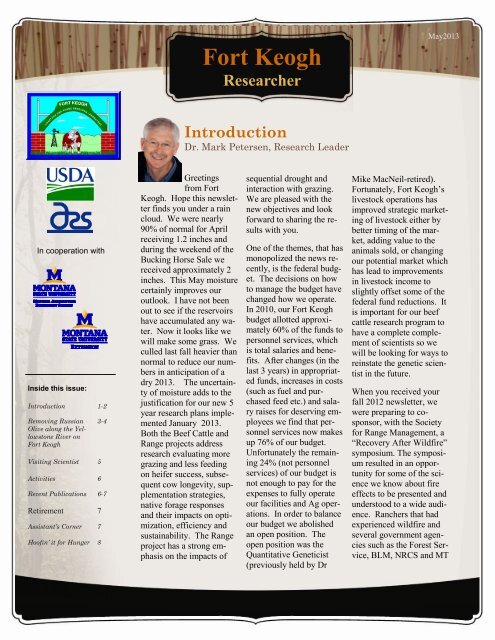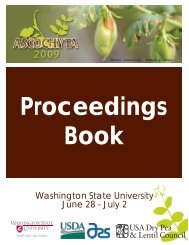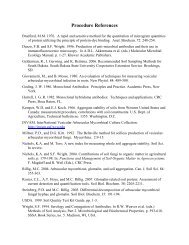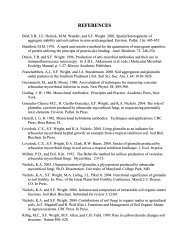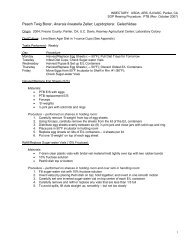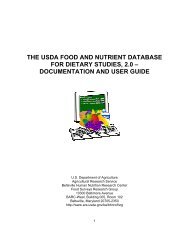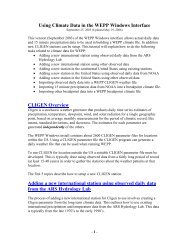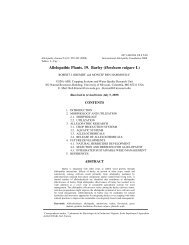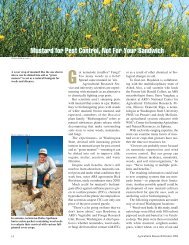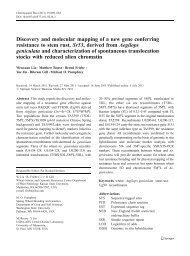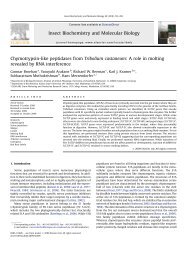Fort Keogh - Agricultural Research Service
Fort Keogh - Agricultural Research Service
Fort Keogh - Agricultural Research Service
Create successful ePaper yourself
Turn your PDF publications into a flip-book with our unique Google optimized e-Paper software.
<strong>Fort</strong> <strong>Keogh</strong><br />
<strong>Research</strong>er<br />
May2013<br />
Introduction<br />
Dr. Mark Petersen, <strong>Research</strong> Leader<br />
In cooperation with<br />
Inside this issue:<br />
Introduction 1-2<br />
Removing Russian<br />
Olive along the Yellowstone<br />
River on<br />
<strong>Fort</strong> <strong>Keogh</strong><br />
Visiting Scientist 5<br />
Activities 6<br />
3-4<br />
Recent Publications 6-7<br />
Retirement 7<br />
Assistant’s Corner 7<br />
Hoofin’ it for Hunger 8<br />
Greetings<br />
from <strong>Fort</strong><br />
<strong>Keogh</strong>. Hope this newsletter<br />
finds you under a rain<br />
cloud. We were nearly<br />
90% of normal for April<br />
receiving 1.2 inches and<br />
during the weekend of the<br />
Bucking Horse Sale we<br />
received approximately 2<br />
inches. This May moisture<br />
certainly improves our<br />
outlook. I have not been<br />
out to see if the reservoirs<br />
have accumulated any water.<br />
Now it looks like we<br />
will make some grass. We<br />
culled last fall heavier than<br />
normal to reduce our numbers<br />
in anticipation of a<br />
dry 2013. The uncertainty<br />
of moisture adds to the<br />
justification for our new 5<br />
year research plans implemented<br />
January 2013.<br />
Both the Beef Cattle and<br />
Range projects address<br />
research evaluating more<br />
grazing and less feeding<br />
on heifer success, subsequent<br />
cow longevity, supplementation<br />
strategies,<br />
native forage responses<br />
and their impacts on optimization,<br />
efficiency and<br />
sustainability. The Range<br />
project has a strong emphasis<br />
on the impacts of<br />
sequential drought and<br />
interaction with grazing.<br />
We are pleased with the<br />
new objectives and look<br />
forward to sharing the results<br />
with you.<br />
One of the themes, that has<br />
monopolized the news recently,<br />
is the federal budget.<br />
The decisions on how<br />
to manage the budget have<br />
changed how we operate.<br />
In 2010, our <strong>Fort</strong> <strong>Keogh</strong><br />
budget allotted approximately<br />
60% of the funds to<br />
personnel services, which<br />
is total salaries and benefits.<br />
After changes (in the<br />
last 3 years) in appropriated<br />
funds, increases in costs<br />
(such as fuel and purchased<br />
feed etc.) and salary<br />
raises for deserving employees<br />
we find that personnel<br />
services now makes<br />
up 76% of our budget.<br />
Unfortunately the remaining<br />
24% (not personnel<br />
services) of our budget is<br />
not enough to pay for the<br />
expenses to fully operate<br />
our facilities and Ag operations.<br />
In order to balance<br />
our budget we abolished<br />
an open position. The<br />
open position was the<br />
Quantitative Geneticist<br />
(previously held by Dr<br />
Mike MacNeil-retired).<br />
<strong>Fort</strong>unately, <strong>Fort</strong> <strong>Keogh</strong>’s<br />
livestock operations has<br />
improved strategic marketing<br />
of livestock either by<br />
better timing of the market,<br />
adding value to the<br />
animals sold, or changing<br />
our potential market which<br />
has lead to improvements<br />
in livestock income to<br />
slightly offset some of the<br />
federal fund reductions. It<br />
is important for our beef<br />
cattle research program to<br />
have a complete complement<br />
of scientists so we<br />
will be looking for ways to<br />
reinstate the genetic scientist<br />
in the future.<br />
When you received your<br />
fall 2012 newsletter, we<br />
were preparing to cosponsor,<br />
with the Society<br />
for Range Management, a<br />
“Recovery After Wildfire”<br />
symposium. The symposium<br />
resulted in an opportunity<br />
for some of the science<br />
we know about fire<br />
effects to be presented and<br />
understood to a wide audience.<br />
Ranchers that had<br />
experienced wildfire and<br />
several government agencies<br />
such as the Forest <strong>Service</strong>,<br />
BLM, NRCS and MT
Introduction<br />
(continued)<br />
Introduction (continued)<br />
DNRC shared their perspectives.<br />
There were over 100 participants in<br />
attendance that took part in a number<br />
of formal and side conversations<br />
about fire and its effects. We are<br />
planning a summer Fire Tour in<br />
South Eastern Montana as requested<br />
by participants at the symposium.<br />
The details of the tour will be distributed.<br />
As a result of this interest,<br />
our Fire Ecology Scientist, Lance<br />
Vermeire, will be conducting research<br />
in collaboration with the Forest<br />
<strong>Service</strong> in the recently burned<br />
areas of the North Dakota National<br />
Grasslands. The Forest <strong>Service</strong> provided<br />
Lance with a $60,000 grant to<br />
conduct his research. Hopefully he<br />
will be able to set up a similar experiment<br />
in SE Montana.<br />
Other news from the <strong>Fort</strong> includes<br />
that the new 5 year projects have<br />
been implemented starting in the fall<br />
of 2012. We are very pleased with<br />
the studies designed. One of the<br />
new studies is a collaborative effort<br />
with the NRCS and the 5 State Missouri<br />
Watershed coalition. An article<br />
on page 3 describes the work<br />
being pursued. The basic tenet is<br />
that <strong>Fort</strong> <strong>Keogh</strong> has an extensive<br />
Russian Olive invasion along the<br />
Yellowstone River that has diminished<br />
grazing. When we remove the<br />
trees, how do we best (low cost and<br />
effective) rehabilitate the land, inhibit<br />
a weed invasion, and return it<br />
to useful habitat.<br />
We will miss Dr. Matt Cronin<br />
(University of Alaska) who was on a<br />
sabbatical at <strong>Fort</strong> <strong>Keogh</strong> for a year.<br />
He worked closely with our genetic/<br />
genomics group evaluating the ancestry<br />
of Polar bears and bison<br />
though genetic relationships to establish<br />
what unique genetic populations<br />
exists. He was a pleasure to<br />
have at the <strong>Fort</strong>. Dr. Travis Mulliniks<br />
was a PhD (NMSU) student who<br />
completed his work with Andy Roberts<br />
and myself is on the faculty in<br />
the Animal Science Department as a<br />
Beef Cattle Nutritionist at University<br />
of Tennessee. Morgan Russell<br />
(NDSU) is finishing her PhD work<br />
with Lance Vermeire (we anticipate<br />
she will be gainfully employed by<br />
next winter) and we have a visiting<br />
doctoral student from Oregon State<br />
University Merilynn (Hirsch)<br />
Schantz who will be returning to<br />
Oregon sometime this summer, and<br />
an undergraduate student Drew Gaskill<br />
(MSU) is back working with<br />
Tom Geary. In spite of the fact that<br />
our budget cuts did not allow us to<br />
hire any summer student interns this<br />
year, we have had visitors working<br />
at the <strong>Fort</strong> and enhancing what we<br />
do.<br />
Lastly we would like to invite you to<br />
participate in a 5k, 10K and half<br />
marathon co-sponsored with the<br />
Farm Bureau as a fund raiser for the<br />
Montana Food Network. It will be<br />
held on October 13, 2013. You can<br />
register on the Farm Bureau web site<br />
http://mfbf.org/event/2012/09/hoofin<br />
-it-for-hunger/.<br />
Please call to set up a visit us for<br />
your group (406-874-8200). It is a<br />
good method for us to visit with everyone<br />
about the work we do here.<br />
Have a good summer.
Removing Russian Olive<br />
along the Yellowstone River<br />
on <strong>Fort</strong> <strong>Keogh</strong><br />
By Jennifer Muscha & Erin Espeland<br />
Who would have thought that a<br />
conversation between Jennifer Muscha<br />
(Rangeland Management Specialist at<br />
<strong>Fort</strong> <strong>Keogh</strong>) and Robert Kilian (NRCS<br />
Area Range Management Specialist in<br />
Miles City) at the 2009 Montana Range<br />
Days in Miles City has now turned into<br />
a major research and demonstration project<br />
on <strong>Fort</strong> <strong>Keogh</strong>. Robert and Jennifer<br />
discussed collaborative projects for <strong>Fort</strong><br />
<strong>Keogh</strong> and the NRCS that would benefit<br />
rangelands on <strong>Fort</strong> <strong>Keogh</strong> and also provide<br />
needed information to NRCS. Removal<br />
of Russian olive along the Yellowstone<br />
River was a high priority. If<br />
Russian olive populations continue to<br />
increase, <strong>Fort</strong> <strong>Keogh</strong> may begin to lose<br />
its cottonwood forests along the river.<br />
Approximately 8 miles of the Yellowstone<br />
River runs through the <strong>Fort</strong> <strong>Keogh</strong><br />
boundary, and Russian olive trees are<br />
creating a dense understory beneath<br />
established cottonwoods. This understory<br />
prevents cottonwood seedlings<br />
from establishing and makes some of<br />
the most productive rangelands at <strong>Fort</strong><br />
<strong>Keogh</strong> inaccessible to livestock.<br />
Robert approached <strong>Research</strong> Leader<br />
Mark Petersen a few weeks later with<br />
the idea and a collaborative project between<br />
the two USDA agencies in Miles<br />
City was initiated. By fall of that year,<br />
we began meetings to discuss the goals<br />
of the project. Joe Scianna (Manger/<br />
Horticulturalist) and Roger Hybner<br />
(<strong>Research</strong> Agronomist) from the USDA-<br />
NRCS Bridger Plant Materials Center<br />
and Erin Espeland (<strong>Research</strong> Ecologist)<br />
from the USDA-ARS in Sidney, MT,<br />
also participated in designing the study.<br />
Our first goal was to determine how<br />
Russian olive trees could be removed<br />
effectively. We started contacting people<br />
who had previously removed Russian<br />
olive to determine the most successful<br />
method for removal. We not<br />
only asked people what method they<br />
used, but also their resprout rates and<br />
what problems arose after Russian olive<br />
removal. Respondents reported resprout<br />
rates ranging from 3 to 60%, commented<br />
that the use of imazapyr resulted in<br />
“dead zones” that could not be revegetated,<br />
and by far the biggest drawback to<br />
Russian olive removal was that other<br />
weeds came in. Most respondents<br />
pointed out that follow-up treatment was<br />
required in the year following removal<br />
to control Russian olive. People who cut<br />
stumps to ground level with a tree shearer<br />
and immediately sprayed the stumps<br />
with a 3:1 ratio of basal bark oil and<br />
triclopyr had the lowest self-reported<br />
resprout rates. This was the technique<br />
we decided to use, in addition to the<br />
follow up herbicide treatment. In the fall<br />
of 2010, <strong>Fort</strong> <strong>Keogh</strong> invested in a brand<br />
new skid steer and tree shearer. We had<br />
hoped to start removing Russian olives<br />
immediately, but due to the large<br />
amount of snow that winter we did not<br />
get started until April of 2011. <strong>Fort</strong>unately,<br />
we finished cutting about 2500<br />
trees in mid May 2011, right before the<br />
Yellowstone River flooded due to heavy<br />
rains.<br />
Our site flooded twice that year,<br />
and because of the flooding of the plots<br />
a number of salt cedar plants germinated<br />
and established in our plots. We treated<br />
the salt cedar with herbicide in 2012.<br />
Without the flooding, we do not think<br />
salt cedar would have been an issue.<br />
Our total Russian olive resprout rate was<br />
4% of all the trees that were cut, but<br />
many of these were root sprouts exposed<br />
by flooding. Without flooding, we suspect<br />
our resprout rate would have been<br />
less than one-half of one percent. Thus,<br />
the method we chose was extremely<br />
effective for removing Russian olive<br />
even with the flooding.<br />
Our second goal was to determine<br />
the benefits of revegetation after Russian<br />
olive removal. Revegetation is<br />
expensive, and little research is available<br />
to show if and when this expense is<br />
justified: sometimes native communities<br />
recover without assistance. At our site,<br />
the Russian olive trees were so dense<br />
that grasses and other plants were not<br />
growing under the trees. In addition,<br />
operation of the skid steer to remove the<br />
dense understory of Russian olive trees<br />
left the ground even more bare and susceptible<br />
to weed invasion. Revegetation<br />
can prevent weed infestations under<br />
some conditions, and our experiment is<br />
designed to test if revegetation prevents<br />
weed problems after Russian olive removal.<br />
The four revegetation treatments<br />
are 1) herbaceous layer only, 2) herbaceous<br />
layer plus shrubs, 3) herbaceous<br />
layer plus trees, 4) herbaceous layer plus<br />
shrubs and trees. The fifth section of the<br />
block contains a control with Russian<br />
olive removed but no revegetation. The<br />
herbaceous treatment included a combi-<br />
Figure 1. Russian olive invaded site, pre-removal at left, during removal at center, post-removal at right.
Removal of Russian Olive<br />
continued<br />
nation of grass and forb species. Each of<br />
these treatments involves a different cost<br />
and labor outlay, and we will compare the<br />
treatments to determine the best practices<br />
to prevent weeds after Russian olive removal.<br />
We also included the norevegetation<br />
treatment as the lowestinvestment<br />
option in order to generate a<br />
cost-benefit analysis of revegetation vs.<br />
weed problems in recovering sites similar<br />
to <strong>Fort</strong> <strong>Keogh</strong>. We have permanent vegetation<br />
transects marked in each subplot<br />
and are also keeping track of all plant<br />
species that germinate. We counted the<br />
number of Russian olive trees cut in each<br />
block and plan to do an economic analysis<br />
on the cost of removing the Russian olive<br />
trees. We continue to count and control<br />
Russian olive resprouts and seedlings that<br />
germinate yearly.<br />
Grasses seeded included slender<br />
wheatgrass (Elymus trachycaulus), western<br />
wheatgrass (Pascopyrum smithii),<br />
prairie cordgrass (Spartina pectinata), and<br />
switchgrass (Panicum virgatum). Forbs<br />
included yarrow (Achillea millefolium),<br />
dotted blazing star (Liatris punctata), prairie<br />
coneflower (Ratibida columnifera),<br />
Canadian milkvetch (Astragalus canadensis),<br />
prairie thermopsis (Thermopsis<br />
rhombifolia), white prairie clover (Dalea<br />
candida), purple prairie clover (Dalea<br />
purpurea), Maximilian sunflower<br />
(Helianthus maximiliani), purple coneflower<br />
(Echinacea angustifolium), and<br />
Lewis flax (Linum lewisii).Tree and shrub<br />
species are shown in Table 1.<br />
Soil was saturated and access to the<br />
site was limited in 2011, so we delayed<br />
revegetation until spring of 2012. A 7 ft.<br />
fence funded by the NRCS and constructed<br />
by <strong>Fort</strong> <strong>Keogh</strong>, NRCS, and the Custer<br />
County Conservation District was built in<br />
the fall of 2011 to protect the trees and<br />
shrubs that would be planted the following<br />
spring from being eaten by wildlife. The<br />
National Wild Turkey Federation (NWTF)<br />
also contributed to funding the project<br />
because cottonwood trees are an important<br />
roosting habitat for turkeys. Unfortunately,<br />
2012 was the second driest year on<br />
record for Miles City and very few seeds<br />
from the herbaceous revegetation treatment<br />
germinated. We are following standard<br />
revegetation guidelines and are waiting<br />
for year three after seeding to determine<br />
the success of the herbaceous revegetation.<br />
Transplanted trees and shrubs were censused<br />
this spring, with 784 plants successfully<br />
established (Table 1). This experiment<br />
has provided the basis for additional<br />
collaborations to scientifically inform restoration<br />
practice and rangeland management.<br />
Transplantation of cottonwood trees<br />
is expensive and it is important that these<br />
plantings are successful. As shown in Table<br />
1, we had very poor establishment of<br />
cottonwood trees in our revegetation experiment.<br />
Does growth of the transplant<br />
Table 1. Planted tree and shrub species with total number successfully established at our<br />
experimental site one year after planting.<br />
Common name Scientific name Number established<br />
Wood’s rose Rosa woodsii 282<br />
silver buffaloberry Shepherdia argentea 104<br />
golden currant Ribes aureum 174<br />
chokecherry Prunus virginiana 70<br />
plains cottonwood Populus deltoides 7<br />
narrow leaf cottonwood Populus angustifolia 2<br />
green ash Fraxinus pennsylvanica 120<br />
box elder Acer negundo 25<br />
prior to planting affect survivorship? To<br />
answer this question, we planted 90 cottonwood<br />
trees along the riverbank at <strong>Fort</strong><br />
<strong>Keogh</strong> in 2011. The cottonwood trees<br />
were started from seed collected at <strong>Fort</strong><br />
<strong>Keogh</strong> and germinated at the Bridger Plant<br />
Materials Center (NRCS). They were<br />
grown in 3 different tubular container sizes<br />
– 10”, 24”, 36” – and the container size<br />
determined the depth to which cottonwood<br />
roots could grow in the pots prior to being<br />
transplanted. One-year survivorship of<br />
cottonwood seedlings from 10” pots was<br />
the lowest at 66.7%. The cottonwood<br />
seedlings grown in 24” and 36” pots both<br />
had high survival rates of 96.7%.<br />
Another collaboration is with the Missouri<br />
River Watershed Coalition (MRWC)<br />
who received a large grant to study Russian<br />
olive removal. They chose <strong>Fort</strong><br />
<strong>Keogh</strong> as one of their research sites, in<br />
part because of our ongoing project begun<br />
in 2009. The MRWC removed Russian<br />
olive trees in the fall of 2012 at two sites<br />
(28 acres) on <strong>Fort</strong> <strong>Keogh</strong> as well as at sites<br />
in Hardin MT, Lovell WY, and Sturgis<br />
SD. These sites have not received revegetation<br />
treatments, and we will follow the<br />
recovery of understory vegetation to determine<br />
how much the flood year of 2011<br />
affected the changed plant community<br />
after Russian olive removal in our 2010<br />
removal experiment at <strong>Fort</strong> <strong>Keogh</strong>. We<br />
can also see if the location of Russian olive<br />
removal (MT, WY, or SD) affects susceptibility<br />
to weed infestation or ability of<br />
the site to recover naturally. Incorporation<br />
of MRWC sites into our study allows us to<br />
give better information to stakeholders<br />
across the northern Great Plains regarding<br />
the costs and benefits of removing Russian<br />
olive.<br />
All of our collaborators have invested<br />
significant funds and labor into this<br />
project. Without everyone’s time and effort<br />
it would not have been possible. This<br />
study provides a perfect platform to study<br />
long-term effects of revegetation and how<br />
disturbances such as invasive species and<br />
their removal affect landscape functioning.<br />
We consider this a long-term research project<br />
that we will evaluate for a number of<br />
years in the future.
Visiting Scientist<br />
On December<br />
26, 2012,<br />
Thiago Martins<br />
stepped on a<br />
plane in Sao<br />
Paulo, Brazil<br />
where it was<br />
92°F and<br />
stepped off a<br />
plane in Billings 22 h later where the<br />
temperature was 16°F into an environment<br />
he had never seen before.<br />
After a stop for long johns, Muck<br />
boots, and Carharts, it was off to a life<br />
at <strong>Fort</strong> <strong>Keogh</strong> for the next six months<br />
to work with Tom Geary and Crystal<br />
Madsen conducting research in reproduction.<br />
Thiago is a 29 year old native of<br />
Sao Paulo and attended grade school<br />
and high school in the city of more<br />
than 11 million (metropolitan area ><br />
20 million) people. He attended the<br />
national university system<br />
(Universidade Estadual Paulista Ju lio<br />
de Mesquita Filho; UNESP) in Aracatuba,<br />
Brazil and graduated in 2007<br />
with a degree in Veterinary Medicine.<br />
He entered a residency program<br />
within the Veterinary Diagnostic Lab<br />
at UNESP in Botucatu, Brazil after<br />
obtaining his degree and was attending<br />
an extension course in the Fall of<br />
2008 when he met Dr. Jose Luiz<br />
Moraes Vasconcelos. Dr. Vasconcelos<br />
is a scientist at UNESP, Botucatu. The<br />
two started to work together on<br />
some projects in animal reproduction<br />
with the goal of improving reproductive<br />
efficiency in Bos indicus (Nelore)<br />
cattle using artificial insemination<br />
(AI). Nelore heifers usually don’t<br />
reach puberty and get exposed to<br />
breeding until they are 2 years old<br />
and it is not uncommon for Nelore<br />
cows to fail to rebreed each year.<br />
Thus, estrous synchronization protocols<br />
that induce puberty or cyclicity<br />
after calving are more valuable to<br />
beef production in Brazil than in the<br />
United States. In mid-2009, Thiago<br />
began a Master of Science program<br />
with Dr. Vasconcelos. His Master’s<br />
degree focused on effects of progesterone<br />
concentration, length of proestrus<br />
and follicle diameter on conception<br />
rate of Nellore heifers inseminated<br />
after estrous detection or submitted<br />
to timed AI. Thiago met Dr. Geary<br />
in Brazil when he was a speaker at an<br />
annual meeting organized by Dr.<br />
Vasconcelos in March 2011. This was<br />
Dr. Geary’s second trip to Brazil and<br />
because his first Brazilian student<br />
(Fernanda Abreu) turned out to be<br />
such a success, Geary was interested<br />
in bringing back another student.<br />
However funding limitations prevented<br />
Thiago from coming to Montana<br />
until this past December. In the<br />
meantime, Thiago completed his Master’s<br />
Degree in November 2011 and<br />
continued to work with Dr. Vasconcelos<br />
until funding became available<br />
for him to come to Montana.<br />
Thiago’s mother and father still<br />
live in the house where he was raised.<br />
His two sisters are now both married,<br />
but still live in Sao Paulo with their<br />
families. Thiago communicates in<br />
Portuguese with his family regularly<br />
via Skype. He is the first of his family<br />
to ever travel outside of South America.<br />
Compared to Montana, Brazil has<br />
just one season, summer, with or<br />
without rain. He has adapted well to<br />
the colder environment (and snow)<br />
here and each time we have a nice<br />
day, asks if winter is over. We tell him<br />
that we will probably still have a<br />
snow storm or two in May, but he<br />
finds that hard to believe. Thiago has<br />
even braved the snow and went skiing<br />
at Red Lodge with the junior high<br />
class of Sacred Heart School in early<br />
March. He may miss snowfall in May<br />
though as he is going to travel to the<br />
University of Missouri to work on research<br />
projects with graduate student<br />
Ky Pohler, and Drs. Mike Smith and<br />
Peter Sutovsky.<br />
Here at <strong>Fort</strong> <strong>Keogh</strong>, Thiago has<br />
been a huge help with an NIH funded<br />
project in heifers aimed at identifying<br />
genetic markers associated with fertility,<br />
collecting blood samples associated<br />
with various projects, evaluating<br />
bull fertility for the annual Line One<br />
Bull Sale and upcoming breeding season,<br />
and perfecting an ovum pick up<br />
procedure in cows that will allow research<br />
on variables affecting oocyte<br />
viability and quality. He is extremely<br />
gifted with ultrasonography and<br />
ovum pick up. Our lab is trying to<br />
develop this technique to enable us to<br />
better characterize some of the factors<br />
affecting fertility. Before Thiago<br />
can apply for graduate school in the<br />
United States, he has to pass an English<br />
proficiency exam (TOEFL) and<br />
score well on the GRE exam. He plans<br />
to take both exams during the next<br />
two months in between helping with<br />
research at Missouri and here at <strong>Fort</strong><br />
<strong>Keogh</strong>. He is working on a grant proposal<br />
to the Brazilian Government to<br />
pursue a PhD in the United States<br />
with Drs. Smith and Geary. Thiago<br />
will have to return to Brazil in mid-<br />
July because of his visa and wait to<br />
hear on the grant proposal.
<strong>Fort</strong> <strong>Keogh</strong><br />
Outreach Activities<br />
<strong>Fort</strong> <strong>Keogh</strong><br />
Current Publications<br />
April 30,2013: Lance Vermeire and<br />
graduate student, Morgan Russell, went<br />
to Sheridan College and talked about<br />
fire at this semester’s Natural Resource<br />
Lecture. Lance’s talk was titled “Fire<br />
<strong>Research</strong> and How to Respond this<br />
Year” and Morgan spoke on “History of<br />
Fire in the Northern Great Plains.”<br />
There was a total of 87 in attendance<br />
including 15 college and 2 high school<br />
students.<br />
April 19, 2013: Kurt Reinhart was invited<br />
to the Graduate Careers Awareness<br />
and Trends Day at the University<br />
of Alabama, Birmingham, AL, to speak<br />
about careers in ARS, specifically opportunities<br />
in Ecology.<br />
April 2013: Ben Rice, Montana State<br />
University student, worked with Diona<br />
on updating the road map using GIS for<br />
his semester project. He remapped over<br />
200 miles of roads.<br />
April 3, 2013: Matt Rinella gave a talk<br />
‘Shrub restoration research update’ at<br />
the Spring Creek Mine, Decker, MT.<br />
April 1, 2013: Andy Roberts talked with<br />
6 students from MCC on the Grow Safe<br />
project.<br />
March 4, 2013: Bill Almy, area rancher,<br />
came in and discussed grazing in<br />
drought with Mark Petersen and Richard<br />
Waterman.<br />
March 2013: Jaclyn Ketchum, a student<br />
at Ekalaka High school and an intern at<br />
<strong>Fort</strong> <strong>Keogh</strong> working with Dr. Tom<br />
Geary and Dr. Andy Roberts, participated<br />
in a science fair competition in<br />
Billings, Montana. She presented a talk<br />
titled: and took first place. She received<br />
a cash prize, a trip to ISEF in Phoenix,<br />
Arizona, and a $1000 scholarship to<br />
Montana State University.<br />
February 21, 2013: Roundtable with<br />
producers – Mark Petersen<br />
February 2013: Dustin Strong gave a<br />
talk to the Miles City Rotary Club titled:<br />
Fire <strong>Research</strong> on Rangelands<br />
February 13, 2013: Lance Vermeire<br />
presented “Fire ecology and fire-grazing<br />
interactions in the northern Great<br />
Plains” at the Dakota Prairie Grasslands<br />
Grazing Association Meeting held at<br />
Comfort Inn in Bismarck, ND.<br />
February 13, 2013: Matt Rinella gave a<br />
talk ‘Using large datasets to estimate<br />
biological parameters’ at the Plant Sciences<br />
Department, University of Sacramento,<br />
California.<br />
February 11, 2013: Matt Rinella gave a<br />
talk ‘Prescribed Grazing, Herbicide, and<br />
Seeding Effects on Invaded Grasslands<br />
of the Northern Great Plains’ at the<br />
Plant Sciences Department, University<br />
of Sacramento, California.<br />
January 7-11, 2013: Mark Petersen presented<br />
at the Ag Winter Series January<br />
7th-11th<br />
December 7, 2012: Held an open house<br />
with tours.<br />
December 1, 2012: Mark discussed feed<br />
alternatives for drought with Bighorn<br />
Grazing Association.<br />
November 30, 2012: Mark Presentation<br />
South Eastern Livestock Association<br />
meeting<br />
Nov. 15, 2012: Morgan Russell hosted<br />
the Ag class from Miles Community<br />
College for a discussion on fire management.<br />
She also took them to tour the<br />
plots where they have burned.<br />
Atkins, J.A., Smith, M.F., MacNeil,<br />
M.D., Jinks, E.M., Abreu, F.M., Alexander,<br />
L.J., Geary, T.W. 2012. Pregnancy<br />
establishment and maintenance<br />
in cattle. Journal of Animal Science<br />
91:722-733.<br />
Cronin, M.A., MacNeil, M.D., Vu, N.,<br />
Leesburg, V,.L.R., Blackburn, H.D.,<br />
Derr, J. 2013. Genetic variation in<br />
bison (bison bison) subspecies and<br />
cattle (Box Taurus) breeds and subspecies.<br />
Journal of Heredity<br />
doi:10.1093/jhered/est030.<br />
Endecott, R.L., Funston, R.L., Mulliniks,<br />
J.T., Roberts, A.J. 2012. Implications<br />
of beef heifer development<br />
systems and lifetime productivity.<br />
Journal of Animal Science 91:1329-<br />
1335.<br />
Fouts, D.E., Szpakowski, S., Purushe,<br />
J., Torralba, M., Waterman, R.C., Macneil,<br />
M.D., Alexander, L.J., Nelson,<br />
K.E. 2012. Next generation sequencing<br />
to define prokaryotic and fungal<br />
diversity in the bovine rumen. PLoS<br />
One. 7(11):e48289<br />
Jinks, E.M., Smith, M.F., Atkins, J.A.,<br />
Pohler, K.G., Perry, G.A., MacNeil,<br />
M.G., Roberts, A.J., Waterman, R.C.,<br />
Alexander, L.J., Geary, T.W. 2013.<br />
Preovulatory estradiol and the establishment<br />
and maintenance of<br />
pregnancy in suckled beef cows.<br />
Journal of Animal Science 91:1176-<br />
1185.<br />
Mulliniks, J.T., Hawkins, D.E., Kane,<br />
K.K., Cox, S.H., Torrell, C.A.,<br />
Scholljegerdes, E.J., Petersen, M.K.<br />
2013. Metabolizable protein supply<br />
while grazing dormant winter forage<br />
during heifer development alters<br />
pregnancy and subsequent in-
Assistant’s Corner<br />
By Brad Eik<br />
herd retention rate. Journal of Animal<br />
Science 91:1409-1416.<br />
Reinhart, K.O. 2012. The organization<br />
of plant communities: negative<br />
plant-soil feedbacks and semiarid<br />
grasslands. Ecology 93(11):2377-<br />
2385.<br />
Reinhart, K.O., Johnson, D., Clay, K.<br />
2012. Conspecific plant-soil feedbacks<br />
of temperate tree<br />
Retirement<br />
Rod Stieg<br />
HVAC Maintenance Specialist<br />
Rod Stieg, Heating, Ventilation, and<br />
Air Conditioning Specialist, retired in<br />
December after 25 years of federal<br />
service. Rod was responsible for all<br />
the maintenance and upkeep of the<br />
main office and laboratory building<br />
inside and out and did a wonderful<br />
job. We will surely miss him though<br />
he will be back occasionally to help<br />
out until a replacement can be hired.<br />
Rod and his wife will be traveling<br />
around the US with their fifth wheel<br />
trailer and finding new adventures<br />
along with hanging out with family<br />
and friends.<br />
Well , here we are again at the close of<br />
Bucking Horse Sale weekend and<br />
watching some beautiful needed rain<br />
come down! Greetings from For t<br />
<strong>Keogh</strong> I hope everyone has had a good<br />
calving season and are getting some of<br />
this moisture for your pastures and<br />
hay land. We are just finishing up with<br />
a few head of cows left to calve and<br />
have branded up everything born so<br />
far. We are in the process of prebreeding<br />
all the cow herds and trying to wait<br />
as long as we can to turn pairs out on<br />
native range to give things a chance to<br />
come back from that dry summer last<br />
year. The drought was terrible on our<br />
native range and pastures, however,<br />
the dry warm weather was great for<br />
our irrigated hay land as we had one of<br />
the best hay years we’ve had in a long<br />
time . We averaged 6 ton/acre on most<br />
of the fields and a little better on some<br />
others. We did sell two of our cow<br />
herds last fall to try and prepare for<br />
this summer possibly being as dry as<br />
last. Our Season Of Calving (SOC)<br />
cow’s project had basically come to an<br />
end and we dispersed them last December.<br />
They were in great condition<br />
and sold very well at MCLC. Our production<br />
sale in March was mediocre at<br />
best . We weren’t sure if it was due to<br />
the droughty spring we had and the<br />
uncertainty of everything or due to the<br />
change of sale dates this year to a<br />
Thanks goes out to Ben Rice, Montana<br />
State University student from Miles<br />
City, for remapping our roads using<br />
GIS technology this spring for his semester<br />
project. Ben drove over 200<br />
miles on <strong>Fort</strong> <strong>Keogh</strong> marking the<br />
roads with his GIS unit and provided<br />
us with a very nice set of data to update<br />
the maps we use for working our<br />
land. We wish Ben luck in his future<br />
endeavors!<br />
Wednesday after the<br />
regular cattle sale<br />
may have effected it also. We averaged<br />
around $2,100.00 on 34 head of bulls<br />
which was down quite a ways from<br />
our $4,002.00 average a year ago. We<br />
did, on a positive note, sell more bulls<br />
to local producers than we ever have<br />
so that was a positive for us. We<br />
would like to thank everyone that<br />
bought a bull and came to the sale we<br />
appreciate the support for our program<br />
greatly.<br />
We have begun the third year of our fly<br />
control study putting out mineral with<br />
IGR starting in April and we will put fly<br />
tags in this summer. We are hoping to<br />
have some good results to share with<br />
everyone this fall.<br />
We do have a number of CGC composite<br />
bulls for sale private treaty if you<br />
find yourselves needing a bull come<br />
take a look. These boys look great!<br />
You won’t be disappointed. With that I<br />
hope everyone is having a good spring<br />
and enjoying nice weather. As always,<br />
if there is anything I can do to help<br />
your programs, please give me a call, I<br />
am glad to do so. Thanks for your time<br />
and take care<br />
Brad A. Eik<br />
Ranch Manager<br />
Phone: 406-874-8226<br />
Cell: 406-853-2635
USDA-ARS<br />
Livestock and Range<br />
<strong>Research</strong> Laboratory<br />
243 <strong>Fort</strong> <strong>Keogh</strong> Road<br />
Miles City, MT 59301-4016<br />
http://www.ars.usda.gov/npa/ftkeogh<br />
If you have email and would rather<br />
Receive this newsletter as a .pdf file,<br />
send an email to:<br />
<strong>Fort</strong>.<strong>Keogh</strong>@ars.usda.gov<br />
,<br />
Hoofin’ it for Hunger Fun Run<br />
Planning is underway with<br />
the Montana Farm Bureau<br />
Young Ranchers for the next<br />
Hoofin’ it for Hunger Fun Run<br />
on October 13, 2013, to be<br />
held at the <strong>Fort</strong> <strong>Keogh</strong> Livestock<br />
and Range <strong>Research</strong><br />
Laboratory at Miles City,<br />
Montana. This year we will<br />
include a 1/2 Marathon, 10K,<br />
5K, and a 1 & 2 mile fun run.<br />
The long runs will be over<br />
dirt roads and trails, so preparation<br />
is a must! The registration<br />
form is available at<br />
http://mfbf.org/<br />
event/2012/09/hoofin-it-forhunger/.<br />
Save the date!<br />
October 13, 2013


